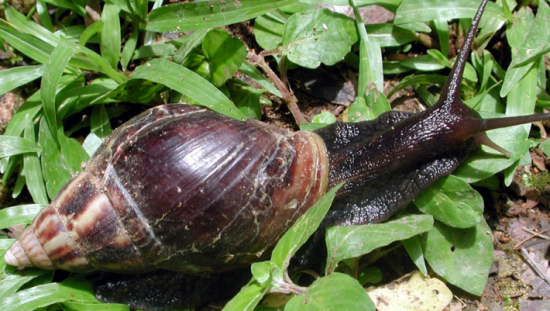
A mature Giant African Land Snail. Courtesy, USDA/APHIS, David G. Robinson
Giant snails that can grow as large as rats have put a Florida town into an unusual quarantine. The invasive creatures carry a parasite that causes meningitis in humans and health officials are taking no chances on letting them spread beyond town limits.
In Florida, these Giant African Land Snails can grow up to eight inches long and they have forced the city of New Port Richey, north of Tampa, into quarantine for the next two years. Unlike the coronavirus lockdowns, residents are simply barred from moving plants, soil, yard waste, debris, compost, and building materials outside the16 square mile zone designated by city officials. The Florida Department of Agriculture and Consumer Services (FDACS) verified that the invasive gastropods had set up shop on June 23 and quarantined the area the next day.
The snails are difficult to eliminate due to the lack of any natural predators. Each snail can live up to nine years and the United States Department of Agriculture (USDA) considers it “the most damaging snail in the world,” dining on more than 500 different plants, and just so happens to have a taste for concrete.
‘Each snail contains both female and male reproductive organs,’ the USDA said in a statement. ‘These snails can reproduce several more times without mating again. They can generate clutches of eggs every two to three months.’
Thankfully, using a pesticide called metaldehyde, which is known for controlling snails and slugs, the city began treatment in late June to remove this pest. The pesticide is approved to be safe for vegetables and most other crops.
At their best, land snails serve an essential role in Florida’s ecosystem. Consuming very low on the food web, most land snails eat decaying vegetation like fallen leaf litter as well as fungi and moist soil. At their worst, we find the Giant African land snails that sometimes grow to the size of rats and carry a parasitic lungworm that causes meningitis in humans. According to the USDA, land snails were first spotted in southern Florida in the 1960s and it took nearly 10 years and $1 million to rid the area of them.
The problem of invasive species in Florida has persisted for decades, from the Burmese Python to the Red Lionfish. We thank the Florida Fish & Wildlife Conservation Commission (FWC) and the Florida Department of Agriculture and Consumer Services (FDACS) for the diligent and caring work they do to help protect Florida’s native species in the face of more detrimental and foreign animals. To learn more about Florida’s invasive species, please visit: https://myfwc.com/wildlifehabitats/nonnatives/.
LMA Newsletter of 7-11-22

